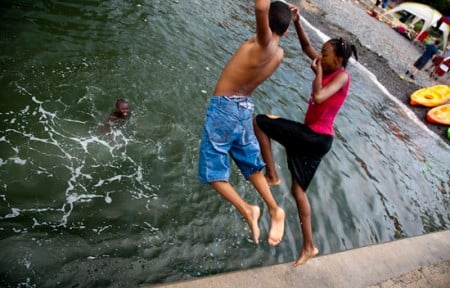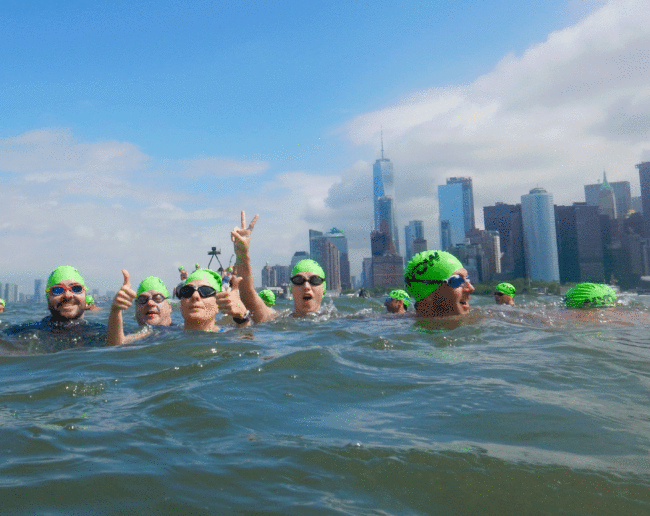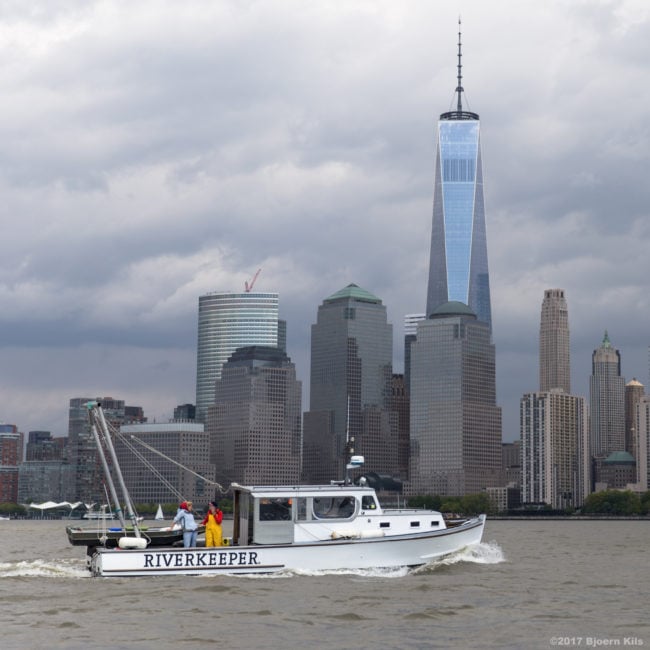Swimming in NYC: The data behind “A beach for Manhattan”

Swimmers in NYC - not at a public beach. (Photo courtesy Paul Bastin)
View more images on our Flickr site
On Monday, the New York Times Editorial Board used its megaphone to promote the idea of opening A beach for Manhattan. Riverkeeper assisted the Times in its research by interpreting some of our key data from 10-plus years of monitoring water quality in the Hudson River Estuary, including all around New York City.
Here’s the bottom line: A beach in Manhattan is more than possible. But we have to improve water quality by reducing and eliminating combined sewer overflows.
Bathing in the city’s rivers has a rich history, and in the late 1800s access to bathing facilities was even mandated by state legislation to promote public health. As pollution and the reputation of pollution ended public bathing, swimming in the natural splendor of the Hudson has been left to intrepid individuals defying the wishes of city authorities, and special events, such as the New York City Triathlon and the world’s longest open water swim event, the 8 Bridges Hudson River Swim. A public beach accessible to all residents would open the waters to the whole city, including those without the means to travel to the outer boroughs.
Public infrastructure investments have resulted in water quality improvements in and around New York City over the last 30+ years that are dramatic and impressive – but combined sewer overflows (CSOs) continue to make water unsafe for swimming too often after rain. There are more than 450 CSOs in New York City, including dozens around Manhattan, that can and do discharge raw sewage when it rains. Stopping sewage overflows is the key next step to expanding recreation and creating a necklace of world-class beaches, parks and preserves in the city’s “sixth borough” – its waterways.
Cleaning up pockets of highly toxic contamination is the other key. Riverkeeper and dozens of partners in the city envision not only a beach in Manhattan, but restored salt marsh ecosystems in Gowanus Canal and Newtown Creek, a vibrant waterfront in Flushing Bay, and recreation along the Bronx and East Rivers.
Go Deeper: Vision Plans for Flushing Waterways and Newtown Creek.
Insights from the data:
Since 2008, Riverkeeper has sampled 74 sites in the Hudson River Estuary monthly, with CUNY Queens College and Columbia University’s Lamont-Doherty Earth Observatory, between NY Harbor and the Capital District. We also sample dozens of East River sites, and work with partners in a large community science project, to sample nearly 300 other locations in the tributaries of the Hudson, and at waterfront locations. Among these partners are the NYC Water Trail Association and The River Project, which coordinate the sampling of dozens of water access points around New York City weekly. One of the 180 individuals who make this unprecedented sampling effort possible is Ira Gershenhorn, who gathers water samples near his Upper West Side home and was featured as The Hudson Swimmer in a catalytic New York Times article July 11.
These community scientists help Riverkeeper and our partners measure concentrations of Enterococcus (Entero), a fecal indicator bacteria. We compare our results to the U.S. Environmental Protection Agency’s (EPA) Recreational Water Quality Criteria. These criteria define safe swimming thresholds based on water quality and epidemiological studies of beachgoers, examining illnesses ranging from skin rashes to eye and ear infections, and upset stomach. Entero is not itself harmful, but because it is a bacteria that lives in the guts of humans and other warm blooded animals, its presence in water indicates the likelihood that other disease-causing pathogens associated with sewage or other fecal contamination (such as from geese) is present.
Of the 15 points Riverkeeper has sampled around New York City, the shoreline sites with the best water quality are at the Pier 96 Kayak Launch in the Hudson River at West 55th Street, and at the beach at Dyckman Street. Based on 68 samples at each location, the geometric mean (a weighted average) of Entero counts were, respectively, 21 and 28 cells per 100 mL of water. Those both fall below the EPA threshold of 30, suggesting good overall water quality for recreation. However, 28% and 18% of those samples, respectively, would have resulted in a beach closure, based on EPA Beach Action Value guidelines. The closures would have resulted from the catastrophic fire at the July 2011 North River Wastewater Treatment Plant (a hopefully one-time occurrence), but also from routine rain storms, resulting in degraded water quality as raw sewage overflowed into the Hudson from the city’s combined sewers. The data suggest that combined sewer overflows could close a beach at locations like these more than once per week, on average.
Similarly, looking at data from New York City Water Trail Association and The River Project, the Pier 40 sampling site in the Hudson River at West Houston Street, shows the best overall water quality, with a geometric mean of 17 (compared to the EPA threshold of 30), based on 126 samples. Here, too, 9% of samples would have resulted in a beach closure. In almost all instances, rain preceded the poor water quality results, suggesting that combined sewer overflows would close a beach at this location, too, roughly one out of every 10 days.
So is it possible to have a beach for Manhattan? Yes. But we have to reduce and eliminate combined sewer overflows, if we want to swim safely even after it rains.
Resources:
Water quality maps: Hudson River and NYC
Water quality maps: Tributaries and NYC access points
Riverkeeper reports: How’s the Water?
NYT Editorial: A beach for Manhattan
Hudson River at Risk 8: City on the Water — Jon Bowermaster from Oceans 8 Films on Vimeo.


